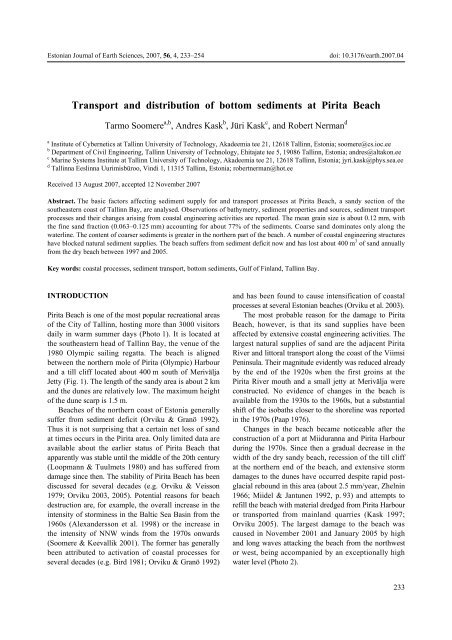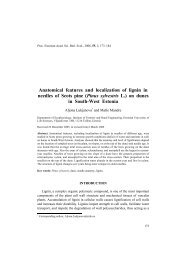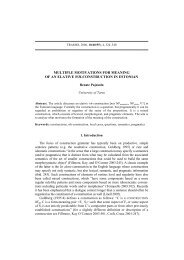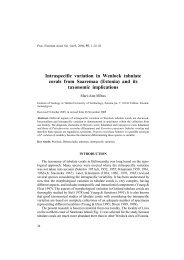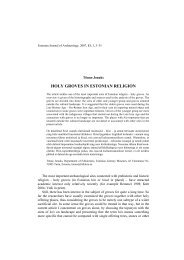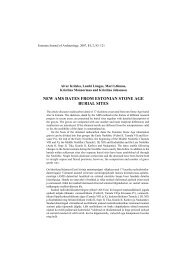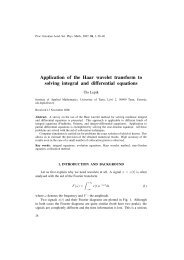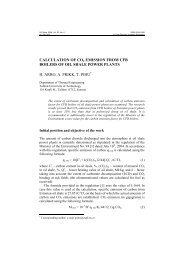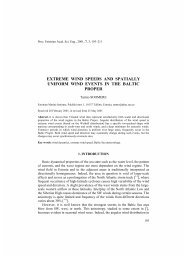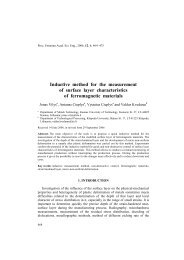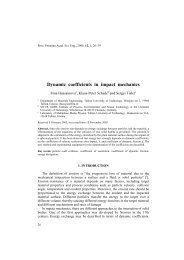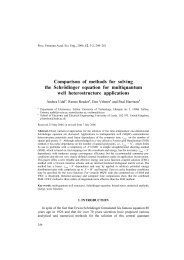Transport and distribution of bottom sediments at Pirita Beach
Transport and distribution of bottom sediments at Pirita Beach
Transport and distribution of bottom sediments at Pirita Beach
- No tags were found...
Create successful ePaper yourself
Turn your PDF publications into a flip-book with our unique Google optimized e-Paper software.
Estonian Journal <strong>of</strong> Earth Sciences, 2007, 56, 4, 233–254Fig. 2. Palaeogeographic map <strong>of</strong> the vicinity <strong>of</strong> <strong>Pirita</strong> <strong>Beach</strong> <strong>and</strong> the <strong>Pirita</strong> River mouth. Redrawn based on Tammekann (1940),Raukas et al. (1965), Kessel & Raukas (1967), <strong>and</strong> an unpublished manuscript Kask (1997). Alvar is a limestone area coveredwith a thin soil layer. In the nomencl<strong>at</strong>ure <strong>of</strong> ancient coastlines, Lim st<strong>and</strong>s for Limnea Sea, L for Litorina Sea, Y for Yoldia Sea,<strong>and</strong> A for Ancylus Lake. The Roman number indic<strong>at</strong>es the development stage <strong>of</strong> these w<strong>at</strong>er bodies <strong>and</strong> the Arabic numbers showthe height <strong>of</strong> the ancient coastline above the contemporary mean w<strong>at</strong>er level.temporary beaches similar to <strong>Pirita</strong> <strong>Beach</strong> (Orviku 1974;Orviku & Granö 1992).An up to 35 m thick complex <strong>of</strong> Qu<strong>at</strong>ernary s<strong>and</strong>claydeposits <strong>of</strong> different origin, lithological composition<strong>and</strong> consistence has accumul<strong>at</strong>ed in the ancient <strong>Pirita</strong>River valley during different stages <strong>of</strong> the Baltic Seaunder the subsequent influence <strong>of</strong> river erosion, icedynamics, sea level changes, <strong>and</strong> deposition <strong>of</strong> <strong>sediments</strong>.The vertical composition <strong>of</strong> <strong>sediments</strong> in theneighbourhood <strong>of</strong> the former restaurant Rannahoone(see Fig. 3) apparently is represent<strong>at</strong>ive for a large part<strong>of</strong> the ancient valley (although several layers are notnecessarily present closer to the borders <strong>of</strong> the valley).Contemporary dune s<strong>and</strong> forms the uppermost 2–2.5 mthick layer th<strong>at</strong> overlies older marine s<strong>and</strong> (thicknessabout 8 m) (Nugis 1971). A thin (0.75–1.60 m) layer <strong>of</strong>silt follows, overlying 4.5–6.5 m thick s<strong>and</strong>y loam th<strong>at</strong>apparently formed during the Ancylus Lake Stage. Belowthese deposits lies an about 9.5–10 m thick layer <strong>of</strong>loam. The lowermost beds consist <strong>of</strong> about 2 m thickhighly plastic varved clay, underlain by Cambrian blueclay.The thickness <strong>of</strong> the Qu<strong>at</strong>ernary complex diminishes<strong>and</strong> its vertical structure undergoes certain changestowards the borders <strong>of</strong> the ancient valley. At the northernborder (<strong>at</strong> Merivälja), a layer <strong>of</strong> till becomes evidenton the surface or below a thin layer <strong>of</strong> contemporarydeposits. Till is in places also traceable under a thinlayer <strong>of</strong> younger <strong>sediments</strong> on the sea <strong>bottom</strong> <strong>at</strong> thesouthwestern border in the Maarjamäe area.The rugged l<strong>and</strong>scape fe<strong>at</strong>ures have thus been levelled<strong>of</strong>f during many millennia. Today the area in questionforms a part <strong>of</strong> the <strong>Pirita</strong>(-Mähe) plane (Raukas et al.1965; Kessel & Raukas 1967) th<strong>at</strong> is gently slopingwestwards. The contemporary s<strong>and</strong>y beach (as well asthe beach th<strong>at</strong> existed south <strong>of</strong> the <strong>Pirita</strong> River until the1970s) lies <strong>at</strong> the western boundary <strong>of</strong> the plane wherethe seabed is gently sloping until a depth <strong>of</strong> about7–8 m. The s<strong>and</strong>y area is limited by the extension <strong>of</strong>the ancient bay, which filled the ancient valley duringdifferent stages <strong>of</strong> the Baltic Sea <strong>and</strong> reached far deeperinto the l<strong>and</strong> in the past (Fig. 2), when the rel<strong>at</strong>ive sealevel was considerably higher.The width <strong>of</strong> the s<strong>and</strong>y beach is up to 100 m <strong>at</strong> thenorthern mole <strong>of</strong> <strong>Pirita</strong> Harbour <strong>and</strong> gradually decreasesnorthwards. S<strong>and</strong> is replaced by a till scarp close toMerivälja Jetty <strong>at</strong> a distance <strong>of</strong> about 2 km from <strong>Pirita</strong>Harbour. Noticeable contemporary dunes <strong>and</strong> valleys236
T. Soomere et al.: Bottom <strong>sediments</strong> <strong>at</strong> <strong>Pirita</strong> <strong>Beach</strong>only exist in the immedi<strong>at</strong>e vicinity <strong>of</strong> the sea coast. Majorsea level changes can be recognized within the valleyfrom much higher ancient dunes (Fig. 2), loc<strong>at</strong>ed about1–2 km inl<strong>and</strong> (Künnapuu 1958; Raukas et al. 1965).Contemporary marine s<strong>and</strong>The properties <strong>of</strong> <strong>bottom</strong> <strong>sediments</strong> for the entire TallinnBay are described in Lutt & Tammik (1992). Previousstudies <strong>of</strong> contemporary <strong>bottom</strong> <strong>sediments</strong> <strong>at</strong> <strong>Pirita</strong> (Lutt1992) are based on 33 sediment samples (Fig. 3) takenwith a vibrocorer (Kudinov 1957). Drill cores extendingdown to 2.1 m into the seafloor (Lutt & Tammik 1992)provide a reliable str<strong>at</strong>igraphy <strong>of</strong> the upper layers <strong>of</strong>marine s<strong>and</strong> <strong>at</strong> <strong>Pirita</strong> (Fig. 4).The seabed from the w<strong>at</strong>erline down to depths <strong>of</strong>2–3 m is covered with fine s<strong>and</strong> <strong>at</strong> <strong>Pirita</strong>. At depths downto 6–8 m rel<strong>at</strong>ively coarse silt is found. In deeper areasFig. 4. Geological cross-sections <strong>of</strong> the beach area. Adaptedfrom Lutt (1992) using the following nomencl<strong>at</strong>ure <strong>of</strong> thegrain size: below 0.01 mm – silt <strong>and</strong> clay; 0.01–0.05 mm –fine silt; 0.05–0.1 mm – coarse silt; 0.1–0.25 mm – fines<strong>and</strong>; 0.25–0.5 mm – medium s<strong>and</strong>; 0.5–1.0 mm – coarses<strong>and</strong>. Loc<strong>at</strong>ion <strong>of</strong> the boreholes is given in Fig. 3.finer silt fractions 1 domin<strong>at</strong>e (Lutt 1992, p. 208). Thelight mineral components (with a specific weight <strong>of</strong>< 2.89 g/cm 3 ) form more than 95% <strong>of</strong> the s<strong>and</strong> mass.Fig. 3. Loc<strong>at</strong>ion <strong>of</strong> samples used for the construction <strong>of</strong> crosssectionsA–B, C–D, <strong>and</strong> E–F (Fig. 4) <strong>of</strong> the upper sedimentlayers in Lutt (1992), Lutt & Tammik (1992), <strong>and</strong> for theanalysis <strong>of</strong> properties <strong>of</strong> <strong>bottom</strong> <strong>sediments</strong>. Filled squaresPR1, PR3, PR7, <strong>and</strong> PR8 denote the starting points <strong>of</strong> beachpr<strong>of</strong>iles 1, 3, 7, <strong>and</strong> 8 in Fig. 7. The box between Rannahoone<strong>and</strong> <strong>Pirita</strong> Harbour indic<strong>at</strong>es the area represented in Fig. 8.1 The classific<strong>at</strong>ion <strong>of</strong> fractions in Lutt (1992) mostly followsth<strong>at</strong> <strong>of</strong> Friedman et al. (1992, pp. 335–340) except th<strong>at</strong>different fractions <strong>of</strong> silt (with the grain size < 0.063 mm)are called silty pelite (grain size from 0.01 to 0.063 mm)<strong>and</strong> pelite (grain size < 0.01 mm). Fractions with the grainsize from 0.063 to 0.2 mm are together referred to as fines<strong>and</strong>, fractions from 0.2 to 0.63 mm as medium s<strong>and</strong>,fractions from 0.63 to 2.0 mm as coarse s<strong>and</strong>, <strong>and</strong> fractionswith the grain size > 2.0 mm as gravel.237
Estonian Journal <strong>of</strong> Earth Sciences, 2007, 56, 4, 233–254Quartz forms about 70% <strong>and</strong> feldspar about 25% <strong>of</strong> them<strong>at</strong>erial.The s<strong>and</strong> deposit is usually over 2 m thick. In thenorthern part <strong>of</strong> the beach (pr<strong>of</strong>ile A–B in Fig. 4) itconsists <strong>of</strong> coarse or fine silt, or <strong>of</strong> a mixture <strong>of</strong> silt <strong>and</strong>pelite (Lutt 1992, pp. 208–213). A thin-layered structure<strong>of</strong> the uppermost <strong>sediments</strong> exists <strong>at</strong> depths <strong>of</strong> 2–10 min the central part <strong>of</strong> the beach (pr<strong>of</strong>ile C–D in Fig. 4).The layered str<strong>at</strong>igraphy may reflect the <strong>at</strong>tempts <strong>at</strong> beachfill (see below); however, such a depositional sequence<strong>of</strong> <strong>bottom</strong> <strong>sediments</strong> is also a typical fe<strong>at</strong>ure <strong>of</strong> s<strong>and</strong>yareas next to North Estonian river mouths (Lutt 1992,p. 215).Several medium- <strong>and</strong> coarse-grained s<strong>and</strong> bodieswere detected in places under a thin s<strong>and</strong> layer southwardfrom the river mouth (pr<strong>of</strong>ile E–F in Fig. 4). Fines<strong>and</strong> forms a thin layer (~ 20 cm) on the sea <strong>bottom</strong> fromthe w<strong>at</strong>erline down to a depth <strong>of</strong> about 4 m <strong>at</strong> about600 m from the coast. At the sampling point, loc<strong>at</strong>edabout 200 m <strong>of</strong>f the coastline, fine s<strong>and</strong> overlies anotherthin layer (~ 15 cm) <strong>of</strong> coarse s<strong>and</strong> <strong>and</strong> till. Silt forms amore than 2 m thick layer <strong>at</strong> w<strong>at</strong>er depths <strong>of</strong> 15–20 m(800–900 m <strong>of</strong>f the coast).The transition between fine <strong>and</strong> coarse s<strong>and</strong> bodiesis quite sharp <strong>at</strong> <strong>Pirita</strong>, whereas the transition betweenfine s<strong>and</strong> <strong>and</strong> different silt fractions is generally gradual.Coarser s<strong>and</strong> bodies are poorly sorted <strong>and</strong> containappreciable amounts <strong>of</strong> 0.05–1.0 mm fractions, whereasfiner s<strong>and</strong> bodies (with the typical grain size <strong>of</strong>0.05–0.25 mm) usually have a narrow grain size range(Lutt 1992). These properties are common for the NorthEstonian s<strong>and</strong>y areas (Lutt 1985; Lutt & Tammik 1992;Kask et al. 2003a).Local sediment transportS<strong>and</strong> transport in the littoral system is usually affectedby a large number <strong>of</strong> various processes such as waveinducedoscill<strong>at</strong>ory motions, wind-induced transport,coastal currents <strong>and</strong> wave-induced alongshore flows,vari<strong>at</strong>ions <strong>of</strong> w<strong>at</strong>er level, sea ice, etc. The effect <strong>of</strong> ice ismostly indirect <strong>and</strong> consists in either damage to duneforest or in reducing the wave loads during the iceseason. The tidal range is 1–2 cm in the Baltic Sea <strong>and</strong>the tidal currents are hardly distinguishable from theother motions. W<strong>at</strong>er level <strong>at</strong> <strong>Pirita</strong> is mainly controlledby hydrometeorological factors. The range <strong>of</strong> its monthlymean vari<strong>at</strong>ions is 20–30 cm (Raudsepp et al. 1999), butits short-term devi<strong>at</strong>ions from the long-term average arelarger <strong>and</strong> frequently reach several tens <strong>of</strong> centimetres.W<strong>at</strong>er levels exceeding the long-term mean more than1 m are rare. The highest measured level <strong>at</strong> the Port <strong>of</strong>Tallinn is 152 cm on 09.01.2005 (Suursaar et al. 2006)<strong>and</strong> the lowest is – 90 cm.Fine s<strong>and</strong> th<strong>at</strong> predomin<strong>at</strong>es <strong>at</strong> <strong>Pirita</strong> (see below)can be easily transported by wind when dry; however,winds sufficient for extensive transport are infrequent.The shoreline is parallel to the predomin<strong>at</strong>ing winds(Soomere & Keevallik 2003). Strong onshore (NW)winds typically occur either during the l<strong>at</strong>e stage <strong>of</strong>storms or during the autumn months when s<strong>and</strong> is wet.Although wind carries a certain amount <strong>of</strong> s<strong>and</strong> to thedune forest, the overall intensity <strong>of</strong> dune building ismodest. The height <strong>of</strong> the existing dunes is a fewmetres. The dunes are mostly covered with grass <strong>and</strong>forest. Only s<strong>and</strong> seawards from the faceted dune faceactively undergoes aeolian transport. The role <strong>of</strong> aeoliantransport has apparently been larger in the past, assuggested by a photo <strong>of</strong> a s<strong>and</strong>storm <strong>at</strong> <strong>Pirita</strong> (Raukas &Teedumäe 1997, p. 291).Coastal currents induced by large-scale circul<strong>at</strong>ionp<strong>at</strong>terns are modest in the whole <strong>of</strong> the Gulf <strong>of</strong> Finl<strong>and</strong>(Alenius et al. 1998). Their speed is typically 10–20 cm/s<strong>and</strong> only in exceptional cases exceeds 30 cm/s in TallinnBay (Orlenko et al. 1984). In the bayheads, such as thenearshore <strong>of</strong> <strong>Pirita</strong> <strong>Beach</strong>, current speeds apparentlyare even smaller (Loopmann & Tuulmets 1980). Localcurrents are <strong>at</strong> times highly persistent in this area (Ermet al. 2006) <strong>and</strong> may provide appreciable transport <strong>of</strong>finer fractions <strong>of</strong> s<strong>and</strong> th<strong>at</strong> are suspended in the w<strong>at</strong>ercolumn, even though the typical settling time <strong>of</strong> thesefractions is only a few minutes <strong>at</strong> the coasts <strong>of</strong> theViimsi Peninsula (Erm & Soomere 2004, 2006).The magnitude <strong>of</strong> wave-induced bedload transportgre<strong>at</strong>ly exceeds th<strong>at</strong> <strong>of</strong> the current-induced transporteven <strong>at</strong> rel<strong>at</strong>ively large depths (8–10 m) in sea areasadjacent to Tallinn Bay (Kask 2003; Kask et al. 2005).Wave action in the surf zone therefore plays a decisiverole in the functioning <strong>of</strong> <strong>Pirita</strong> <strong>Beach</strong>. This is a typicalproperty <strong>of</strong> beaches loc<strong>at</strong>ed in microtidal seas.Most <strong>of</strong> the waves affecting <strong>Pirita</strong> <strong>Beach</strong> origin<strong>at</strong>efrom the Gulf <strong>of</strong> Finl<strong>and</strong>. Western winds bring to the<strong>Pirita</strong> area wave energy stemming from the northernsector <strong>of</strong> the Baltic Proper. The wind regime in theseareas is strongly anisotropic (Mietus 1998; Soomere &Keevallik 2003). Tallinn Bay is well sheltered fromhigh waves coming from a large part <strong>of</strong> the potentialdirections <strong>of</strong> strong winds (Soomere 2005a). The localwave clim<strong>at</strong>e is rel<strong>at</strong>ively mild compared to th<strong>at</strong> in theopen part <strong>of</strong> the Gulf <strong>of</strong> Finl<strong>and</strong> or in the adjacent seaareas. The annual mean significant wave height is aslow as 0.29–0.32 m in different sections <strong>of</strong> <strong>Pirita</strong> <strong>Beach</strong>(Soomere et al. 2005).Very high waves, however, occasionally penetr<strong>at</strong>einto Tallinn Bay <strong>and</strong> cause intense erosion <strong>of</strong> its coasts(Lutt & Tammik 1992; Kask et al. 2003b). The significantwave height usually exceeds 2 m each year, but mayreach 4 m in NNW <strong>and</strong> western storms in the central part238
Estonian Journal <strong>of</strong> Earth Sciences, 2007, 56, 4, 233–254section <strong>of</strong> the river mouth during a two-year period(Loopmann & Tuulmets 1980). Since the river flowonly transports about 400 m 3 <strong>of</strong> <strong>sediments</strong> annually(Lutt & Kask 1992), a large amount <strong>of</strong> marine s<strong>and</strong>apparently was carried <strong>and</strong> accumul<strong>at</strong>ed to the rivermouth (Loopmann & Tuulmets 1980).Substantial development works were performed <strong>at</strong><strong>Pirita</strong>, rel<strong>at</strong>ed to the construction <strong>of</strong> the Olympic sailingharbour in the mid-1970s. The basin <strong>of</strong> the harbour wasexp<strong>and</strong>ed considerably. The combined marina <strong>and</strong> a riverharbour were designed for 750 vessels. The northerngroin was lengthened <strong>and</strong> completely reconstructed.Another breakw<strong>at</strong>er was erected to protect the southernside <strong>of</strong> the harbour.Both marine hydrodynamic fe<strong>at</strong>ures <strong>and</strong> s<strong>and</strong> transportproperties <strong>of</strong> the river flow were notably changed,although the seaward extension <strong>of</strong> the harbour is closeto th<strong>at</strong> <strong>of</strong> the earlier groins (cf. Figs 1, 5, 6). The w<strong>at</strong>erdepth <strong>at</strong> the harbour entrance is about 5 m (EVA 1998).The coastal processes <strong>at</strong> different sides <strong>of</strong> the harbourare therefore practically disconnected. The river flowslows down considerably in the harbour basin, whichacts as a sediment trap, <strong>and</strong> a much smaller amount <strong>of</strong>very fine <strong>sediments</strong> reaches the sea. The m<strong>at</strong>erial stillsupplied to the sea is deposited into areas deeper than4–5 m, far <strong>of</strong>fshore from the equilibrium beach pr<strong>of</strong>ile.The fluvial m<strong>at</strong>erial thus has almost no chance to enterthe active s<strong>and</strong> body <strong>of</strong> the beach.The sea coast south <strong>of</strong> the <strong>Pirita</strong> River mouth wasreclaimed using dredged s<strong>and</strong> to provide l<strong>and</strong> for theOlympic village. The s<strong>and</strong>y beach was largely modifiedby the seawall <strong>of</strong> the new road to <strong>Pirita</strong>. There is aminimum amount <strong>of</strong> s<strong>and</strong> in this area now <strong>and</strong> we ignoreit for estim<strong>at</strong>es <strong>of</strong> the sediment budget.To summarize, the extensive coastal engineeringactivities have largely blocked the littoral drift <strong>and</strong>supplies <strong>of</strong> s<strong>and</strong> to <strong>Pirita</strong> <strong>Beach</strong>. The remaining sources<strong>of</strong> coarser m<strong>at</strong>erial are the till cliff <strong>at</strong> the northern end <strong>of</strong>the beach <strong>and</strong> the dunes. The intensity <strong>of</strong> their erosiondepends mostly on the joint occurrence <strong>of</strong> high w<strong>at</strong>erlevel <strong>and</strong> intense waves. This misbalance <strong>of</strong> the supply<strong>of</strong> different fractions is expected to lead to a decrease inthe dominant grain size <strong>and</strong> an overall worsening <strong>of</strong> thes<strong>and</strong> quality from the recre<strong>at</strong>ional viewpoint. On theother h<strong>and</strong>, the Olympic Harbour also prevents the l<strong>at</strong>erals<strong>and</strong> loss from <strong>Pirita</strong> <strong>Beach</strong> towards the bayhead <strong>and</strong>thus stabilizes the beach to some extent.Changes in the beachThe coastline <strong>and</strong> the whole beach apparently werestable for <strong>at</strong> least a century until the 1970s. There wereno identifiable changes to the coastline between therestaurant <strong>and</strong> Merivälja Jetty in 1940–1976 (Loopmann& Tuulmets 1980). No records <strong>of</strong> substantial changesalso seem to exist from the last 200–300 years duringwhich the largest events in this area have generally beendocumented.Noticeable changes only occurred in the vicinity <strong>of</strong>the <strong>Pirita</strong> River mouth owing to the joint influence <strong>of</strong>the groins <strong>and</strong> dumping <strong>of</strong> <strong>sediments</strong> from the basin <strong>of</strong>the Olympic Harbour. The width <strong>of</strong> the beach in itsmiddle section in the 1960s (60–70 m, Soomere et al.2005) was larger than nowadays (cf. also Raukas &Teedumäe 1997, p. 291). There are no reliable d<strong>at</strong>a tojudge if this fe<strong>at</strong>ure was n<strong>at</strong>ural or was induced by thegroins. The width <strong>of</strong> the dry beach was rel<strong>at</strong>ively largein the southern part <strong>of</strong> the beach already by the 1950s(Fig. 5) <strong>and</strong> increased up to 200 m along the northernmole by the 1970s (Loopmann & Tuulmets 1980). Alimited shift <strong>of</strong> the coastline seawards occurred <strong>at</strong> thesouthern mole <strong>and</strong> in a short section <strong>at</strong> Maarjamäe.The combin<strong>at</strong>ion <strong>of</strong> the engineering structures formsa probable background <strong>of</strong> b<strong>at</strong>hymetric changes near <strong>Pirita</strong>Harbour, which were first identified in the mid-1970s.The isob<strong>at</strong>hs <strong>at</strong> 2 m <strong>and</strong> larger depths were shifted by40–50 m shorewards between 1958 <strong>and</strong> 1976 in a largearea north <strong>of</strong> the harbour (Paap 1976). This processreflects a loss <strong>of</strong> a large volume <strong>of</strong> s<strong>and</strong> from areasadjacent to the new harbour <strong>at</strong> certain depths.To mitig<strong>at</strong>e the consequences <strong>of</strong> coastal engineeringstructures, an estim<strong>at</strong>ed amount <strong>of</strong> about 65 000 m 3 <strong>of</strong> thes<strong>and</strong> dredged from the basins <strong>of</strong> Olympic Harbour wasdumped in the central <strong>and</strong> northern parts <strong>of</strong> <strong>Pirita</strong> <strong>Beach</strong><strong>and</strong> into shallow w<strong>at</strong>er near Merivälja Jetty in the 1970s.It was expected th<strong>at</strong> waves would transport the s<strong>and</strong>southwards to <strong>Pirita</strong> <strong>Beach</strong>. As s<strong>and</strong> in over 1 m deepw<strong>at</strong>er is not necessarily transported alongshore <strong>at</strong> <strong>Pirita</strong>(Soomere et al. 2005), it is unclear how much s<strong>and</strong>actually reached the beach. As the s<strong>and</strong> dredged fromthe harbour was quite fine (Orviku & Veisson 1979),a large part <strong>of</strong> it apparently was transported seawards<strong>and</strong> the width <strong>of</strong> the beachface decreased already by the1980s (Kask 1997). Also, a certain amount <strong>of</strong> quarrys<strong>and</strong> was placed near Rannahoone about 500 m north <strong>of</strong>the <strong>Pirita</strong> River mouth. This considerably increased thes<strong>and</strong> volume <strong>and</strong> apparently prevented the central <strong>and</strong>southern parts <strong>of</strong> <strong>Pirita</strong> <strong>Beach</strong> from erosion.The images in Figs 5 <strong>and</strong> 6 reflect the presence <strong>of</strong> asubstantial amount <strong>of</strong> s<strong>and</strong> in underw<strong>at</strong>er bars in 1951.Comparison with l<strong>at</strong>er images (Photo 4) suggests th<strong>at</strong>the amount <strong>of</strong> active s<strong>and</strong> in bars has been reduced sincethen. Because the width <strong>of</strong> the contemporary beachis considerably smaller, a large amount <strong>of</strong> <strong>sediments</strong>apparently has been lost seawards. The n<strong>at</strong>ure <strong>of</strong> changesis different in different parts <strong>of</strong> the beach.242
T. Soomere et al.: Bottom <strong>sediments</strong> <strong>at</strong> <strong>Pirita</strong> <strong>Beach</strong>In the southern part, between the restaurant <strong>and</strong><strong>Pirita</strong> Harbour, the width <strong>of</strong> the beach <strong>and</strong> the total s<strong>and</strong>volume have increased. This has resulted from beachrenourishment <strong>and</strong> the influence <strong>of</strong> <strong>Pirita</strong> Harbour, whichalmost completely blocks the southward littoral drift.This apparently is a long-term trend, since even the mostviolent storms in 2001 <strong>and</strong> 2005 have not affected thebeach width. The total width <strong>of</strong> the dry beach is up to100 m. In elev<strong>at</strong>ion the beach extends up to 2 m abovethe mean w<strong>at</strong>er level. Waves did not reach the dune toeeven during extreme w<strong>at</strong>er levels. This sector <strong>of</strong> beachtherefore seems rel<strong>at</strong>ively stable <strong>and</strong> is characterized bygradual s<strong>and</strong> accumul<strong>at</strong>ion.The central part <strong>of</strong> the beach (adjacent to therestaurant <strong>and</strong> extending to about 1 km from the <strong>Pirita</strong>River mouth) is in a near-equilibrium st<strong>at</strong>e. The bluff <strong>at</strong>the back <strong>of</strong> the beach is <strong>at</strong> times eroded to some extentin strong storms. Rel<strong>at</strong>ively intense aeolian s<strong>and</strong> transportinto the dune forest occurs in this sector (Kask & Kask2002). Although this may have an adverse effect on thedune forest, it can be interpreted as an expression <strong>of</strong> anexcess <strong>of</strong> s<strong>and</strong> <strong>and</strong> a generally healthy st<strong>at</strong>e <strong>of</strong> the beach.The northern part <strong>of</strong> the s<strong>and</strong>y beach, an about 1 kmlong sector, is changing actively. Strong western storms<strong>and</strong> high storm surges (Photo 2) caused extensiveregression <strong>of</strong> the bluff in 1999–2005. The changes aremarked to the north <strong>of</strong> the mouth <strong>of</strong> a small stream(th<strong>at</strong> discharges to the sea about 900 m north <strong>of</strong> <strong>Pirita</strong>Harbour; see its loc<strong>at</strong>ion in Fig. 3) <strong>and</strong> are substantialin the northernmost part <strong>of</strong> the s<strong>and</strong>y beach. Therecession <strong>of</strong> the bluff was on average 1–2 m (<strong>at</strong> a fewsections even 3–5 m) in 1999–2001. The most intenseerosion occurred <strong>at</strong> the interface between the s<strong>and</strong>y<strong>and</strong> till coasts. A large amount <strong>of</strong> s<strong>and</strong> was carriedinto the dune forest. Several dozens <strong>of</strong> pine-trees weredestroyed <strong>and</strong> this additionally weakens the stability <strong>of</strong>the dunes.The section <strong>of</strong> the coast between the northern end <strong>of</strong>the s<strong>and</strong>y beach <strong>and</strong> Merivälja Jetty embraces a till scarpabout 400 m south <strong>of</strong> the jetty, which is intensivelyeroded during high w<strong>at</strong>er level conditions. Seawardsfrom the scarp there is a gently sloping sea floor, witha width <strong>of</strong> the dry area up to 100 m in low w<strong>at</strong>erconditions, mostly covered by pebbles, cobbles, <strong>and</strong>boulders. This section illustr<strong>at</strong>es intense sediment transitin high w<strong>at</strong>er level conditions.Approxim<strong>at</strong>ely 50% <strong>of</strong> <strong>Pirita</strong> <strong>Beach</strong> therefore suffersfrom substantial damage <strong>at</strong> times. One reason behindan apparent intensific<strong>at</strong>ion <strong>of</strong> beach processes is thehigh frequency <strong>of</strong> storms experienced since the 1960s(Alex<strong>and</strong>ersson et al. 1998). Still, a major thre<strong>at</strong> to thebeach is human activity th<strong>at</strong> has considerably weakenedthe s<strong>and</strong> supply to the beach. Another potential thre<strong>at</strong> isthe influence <strong>of</strong> long waves from fast ferries on theseaward end <strong>of</strong> the equilibrium beach pr<strong>of</strong>ile (Soomere2005b). Given the circumstances, one cannot expect th<strong>at</strong><strong>Pirita</strong> <strong>Beach</strong> will further develop in a stable manner,although the n<strong>at</strong>ural variability <strong>of</strong> storms may providerel<strong>at</strong>ively long periods during which the evolution isfairly slow.Quantific<strong>at</strong>ion <strong>of</strong> changesThe changes in the beach th<strong>at</strong> have occurred since themid-1970s can be roughly quantified by the comparison<strong>of</strong> maps stemming from different decades or the results<strong>of</strong> topographical surveys.If the s<strong>and</strong> volume were constant <strong>at</strong> <strong>Pirita</strong>, thecoastline would shift seawards <strong>and</strong> a gain <strong>of</strong> dry l<strong>and</strong>would occur owing to the postglacial rebound. A roughestim<strong>at</strong>e based on the comparison <strong>of</strong> the loc<strong>at</strong>ion <strong>of</strong> thew<strong>at</strong>erline on a topographic map (1 : 25 000) from 1979<strong>and</strong> the digital Estonian Base Map (1 : 50 000) from theend <strong>of</strong> the 1990s combined with an estim<strong>at</strong>e <strong>of</strong> theeffect <strong>of</strong> l<strong>and</strong> uplift, suggests th<strong>at</strong> the net s<strong>and</strong> loss <strong>at</strong><strong>Pirita</strong> is about 1000–1500 m 3 annually (Soomere et al.2005). The accuracy <strong>of</strong> the underlying inform<strong>at</strong>ion, however,is equivocal <strong>and</strong> this estim<strong>at</strong>e should be consideredas indic<strong>at</strong>ive only. A more detailed analysis <strong>of</strong> historicald<strong>at</strong>a is in progress <strong>and</strong> will be published elsewhere.The above estim<strong>at</strong>e only accounts for the changes inthe s<strong>and</strong> within the equilibrium pr<strong>of</strong>ile <strong>and</strong> in the tillcliff, <strong>and</strong> ignores the potential changes in the amount <strong>of</strong>s<strong>and</strong> in berms <strong>and</strong> foredunes. The sp<strong>at</strong>ial p<strong>at</strong>terns <strong>of</strong> thesechanges, inferred from beach pr<strong>of</strong>iles measured regularlywithin the framework <strong>of</strong> n<strong>at</strong>ional coastal monitoring, areconsistent with the qualit<strong>at</strong>ive analysis above (Suurojaet al. 2004). The erosion <strong>of</strong> the dry beach <strong>and</strong> thescarp is most evident in the northernmost section. Forpr<strong>of</strong>ile 1 (Fig. 7; see loc<strong>at</strong>ion <strong>of</strong> the pr<strong>of</strong>ile in Fig. 3) thewhole coastal pr<strong>of</strong>ile is shifted by 10–20 m l<strong>and</strong>wards.The central part <strong>of</strong> the beach is close to an equilibriumst<strong>at</strong>e (cf. pr<strong>of</strong>ile 3 in Fig. 7). There is some s<strong>and</strong>accumul<strong>at</strong>ion in the southernmost beach sector asindic<strong>at</strong>ed by pr<strong>of</strong>iles 7 <strong>and</strong> 8.A complementary estim<strong>at</strong>e <strong>of</strong> the loss <strong>of</strong> dry s<strong>and</strong>can be derived based upon the comparison <strong>of</strong> isolinesobtained from two subsequent topographic surveys <strong>of</strong>the beach. A comparison <strong>of</strong> the entire topography wouldbe more exact, but the relevant d<strong>at</strong>a are not available.The results <strong>of</strong> two high-resolution (1 : 500) topographicalmappings from 1997 <strong>and</strong> 2006 suggest th<strong>at</strong> nonet changes in the dry l<strong>and</strong> area occurred during thisperiod, but system<strong>at</strong>ic l<strong>and</strong>ward shift <strong>of</strong> the isolines <strong>of</strong>0.5, 1.0, <strong>and</strong> 1.5 m took place (Fig. 8, Table 2). Suchshifts suggest th<strong>at</strong> the s<strong>and</strong>y beach has lost a certain243
Estonian Journal <strong>of</strong> Earth Sciences, 2007, 56, 4, 233–254Fig. 7. <strong>Beach</strong> pr<strong>of</strong>iles 1 (a), 3 (b), 7 (c), <strong>and</strong> 8 (d) <strong>at</strong> <strong>Pirita</strong> on9 Sept. 2003 (solid lines) <strong>and</strong> in 1994 (dashed lines) based ond<strong>at</strong>a from Suuroja et al. (2004). The pr<strong>of</strong>iles begin from thecoastal scarp marked by a circle; refer to Fig. 3 for theirloc<strong>at</strong>ion. The horizontal dashed line shows the mean w<strong>at</strong>erlevel.amount <strong>of</strong> s<strong>and</strong>. As the l<strong>and</strong>scape <strong>of</strong> the beach mayeasily undergo considerable changes in the immedi<strong>at</strong>evicinity <strong>of</strong> the w<strong>at</strong>erline, changes below the 0.5 melev<strong>at</strong>ion may be temporary <strong>and</strong> are not accounted for.S<strong>and</strong> loss may only occur from between the w<strong>at</strong>erline<strong>and</strong> the dune scarp, the l<strong>at</strong>ter being represented by the1.5 m isoline <strong>at</strong> <strong>Pirita</strong>.The overall st<strong>at</strong>e <strong>of</strong> the beach, however, is not good:the isoline shifts indic<strong>at</strong>e the loss <strong>of</strong> s<strong>and</strong> from largesections <strong>of</strong> the beach. The change in the areas <strong>of</strong> therelevant elev<strong>at</strong>ion is between 2000 <strong>and</strong> 5000 m 2 . Thelargest changes have occurred <strong>at</strong> the elev<strong>at</strong>ions <strong>of</strong>1–1.5 m. The relevant isolines are shifted 2–3 m l<strong>and</strong>wardson average. As the typical width <strong>of</strong> the strip<strong>of</strong> dry s<strong>and</strong> is about 50 m, it means th<strong>at</strong>, on average,<strong>at</strong> least 2 m 3 (about 5% <strong>of</strong> dry s<strong>and</strong> volume) <strong>of</strong> s<strong>and</strong>has been lost from each metre <strong>of</strong> the s<strong>and</strong>y area. It isFig. 8. Changes in the loc<strong>at</strong>ion <strong>of</strong> isolines <strong>of</strong> surface elev<strong>at</strong>ionin the southern part <strong>of</strong> <strong>Pirita</strong> <strong>Beach</strong>. Solid <strong>and</strong> dashed linesshow the 0, 0.5, 1, <strong>and</strong> 1.5-m isolines according to surveys<strong>of</strong> 1997 by REIB Llc (Map 1 : 500 with technological networks.Harju County, Tallinn, <strong>Pirita</strong> District, <strong>Pirita</strong> <strong>Beach</strong>.Contract No. 06-612) <strong>and</strong> <strong>of</strong> 2006 by Hectare Llc (Mapwith technological networks. Survey <strong>of</strong> trasses <strong>of</strong> <strong>Pirita</strong><strong>Beach</strong>. Contract No. TT-0249), respectively. The shadedarea represents changes in the positions <strong>of</strong> the isolinesbetween 1997 <strong>and</strong> 2006. The seaward shift <strong>of</strong> the 0.5–1.5-misolines reflects s<strong>and</strong> accumul<strong>at</strong>ion in this area. The representedarea is denoted by a box between Rannahoone <strong>and</strong> <strong>Pirita</strong>Harbour in Fig. 3.interesting to notice th<strong>at</strong> this loss is roughly equal to theestim<strong>at</strong>ed loss <strong>of</strong> finer <strong>sediments</strong> owing to wakes fromfast ferries (Erm & Soomere 2004, 2006). Given thelength <strong>of</strong> the surveyed section is 1800 m, the net loss <strong>of</strong>s<strong>and</strong> is about 3000–4000 m 3 <strong>and</strong> corresponds to theannual loss <strong>of</strong> s<strong>and</strong> volume <strong>of</strong> about 400 m 3 .Table 2. Changes in the dry l<strong>and</strong> area <strong>and</strong> in the area <strong>of</strong> sectionsbordered by the isolines <strong>of</strong> 0.5, 1.0, <strong>and</strong> 1.5 m along a 1800 mlong beach section <strong>at</strong> <strong>Pirita</strong> during 1997–2006Isolineelev<strong>at</strong>ion, mLoss, m 2 Gain, m 2 Balance, m 20.0 1860 1860 00.5 2600 360 – 22401.0 4970 230 – 47401.5 5400 1550 – 3950244
T. Soomere et al.: Bottom <strong>sediments</strong> <strong>at</strong> <strong>Pirita</strong> <strong>Beach</strong>CONTEMPORARY BATHYMETRY ANDBOTTOM SEDIMENTSMapping <strong>of</strong> sediment texture <strong>and</strong> b<strong>at</strong>hymetryThe detailed s<strong>and</strong> budget <strong>of</strong> a beach is usually establishedbased on long-term surveys. The situ<strong>at</strong>ion is simpler forbayhead beaches such as <strong>Pirita</strong> <strong>Beach</strong> th<strong>at</strong> (i) mainlyserve as end points <strong>of</strong> littoral transport for which thel<strong>at</strong>eral losses owing to alongshore transport are negligible,<strong>and</strong> (ii) which are subject to small seasonal changes <strong>and</strong>overall moder<strong>at</strong>e wave activity. Such beaches are usuallyclose to an equilibrium st<strong>at</strong>e. Many <strong>of</strong> their propertiescan be described with the use <strong>of</strong> a small number <strong>of</strong>parameters (e.g. Dean & Dalrymple 2002). One <strong>of</strong> thebasic quantities is the typical grain size.During the field campaign <strong>of</strong> 2005–2007, b<strong>at</strong>hymetry<strong>and</strong> sediment texture were mapped in the nearshorebetween the w<strong>at</strong>erline <strong>and</strong> the 11 m depth contour fromthe northern mole <strong>of</strong> <strong>Pirita</strong> Harbour to Merivälja Jetty.The total length <strong>of</strong> the study area (Fig. 9) along the w<strong>at</strong>erlineis about 2.5 km.Granulometric (textural) analysis <strong>of</strong> <strong>Pirita</strong> <strong>Beach</strong> wasperformed on 51 samples from the upper 30 cm layer <strong>of</strong><strong>bottom</strong> <strong>sediments</strong> taken during the 2005 campaign overthe entire study area, <strong>and</strong> on 18 samples from the nearshoretaken in 2007 (Fig. 9). The majority <strong>of</strong> the samplingpoints in 2005 are loc<strong>at</strong>ed along five pr<strong>of</strong>iles transversalto the coastline. Each pr<strong>of</strong>ile contains about 10 samplesfrom the w<strong>at</strong>erline to the 10 m isob<strong>at</strong>h. A selection fromthe st<strong>and</strong>ard set <strong>of</strong> sieves with the grid size <strong>of</strong> 2.0, 1.0,0.63, 0.5, 0.25, 0.2, 0.125, <strong>and</strong> 0.063 mm (DIN 4022)was used in the analysis performed in the labor<strong>at</strong>ory <strong>of</strong>the Estonian Geological Survey <strong>and</strong> in the EstonianEnvironmental Research Centre. The correspondingφ -values are – 1.0, 0, 2 3 , 1.0, 2.0, 12 , 3.0, <strong>and</strong> 4.0.3The mean grain size M φ, its value in physical unitsd , <strong>and</strong> the st<strong>and</strong>ard devi<strong>at</strong>ion 50σφ<strong>of</strong> the grain size arefound, as recommended in Dean & Dalrymple (2002,Ch. 2), from the values <strong>of</strong> φ84<strong>and</strong> φ : 16φ84+ φ16φ84−φ16M φ= , σ φ= ,2 2assuming the log-normal <strong>distribution</strong> <strong>of</strong> the grain size.The values <strong>of</strong> φ 84<strong>and</strong> φ 16represent the grain sizes,from which 84% or 16% <strong>of</strong> the entire sediment mass hasa larger grain size. Their approxim<strong>at</strong>e values (Table 3)are found from the cumul<strong>at</strong>ive <strong>distribution</strong>s <strong>of</strong> the grainsize (Fig. 10).B<strong>at</strong>hymetric mapping was conducted by Gotta Ltdwith the echo sounder B<strong>at</strong>hy 500 MF <strong>and</strong> the DGPSsystem Trimble DSM 132 in April 2006. The measurementswere performed along 20 transects perpendicularto the coast <strong>and</strong> separ<strong>at</strong>ed by about 100 m, <strong>and</strong> 3transects along the coastline. The sp<strong>at</strong>ial resolution <strong>of</strong>sampling along transects was about 1.5 m.B<strong>at</strong>hymetryThe available beach pr<strong>of</strong>iles (Fig. 7) confirm th<strong>at</strong> thenearshore <strong>of</strong> <strong>Pirita</strong> <strong>Beach</strong> is generally very gently sloping(Suuroja et al. 2004). The slope <strong>of</strong> the pr<strong>of</strong>iles in theshallow w<strong>at</strong>er (depth < 1 m) <strong>of</strong> the northern part <strong>of</strong> thebeach is about 1 : 100 <strong>and</strong> well m<strong>at</strong>ches the estim<strong>at</strong>es <strong>of</strong>the properties <strong>of</strong> the equilibrium beach pr<strong>of</strong>ile (Soomereet al. 2005). The same average slope holds for pr<strong>of</strong>ile 3Table 3. Parameters <strong>of</strong> s<strong>and</strong> <strong>at</strong> <strong>Pirita</strong> <strong>Beach</strong> based on surveys<strong>of</strong> 2005 <strong>and</strong> 2007 (Soomere et al. 2007; Kask & Kask 2007).See text for explan<strong>at</strong>ion <strong>of</strong> symbolsFig. 9. Sampling points <strong>of</strong> <strong>bottom</strong> <strong>sediments</strong> <strong>at</strong> <strong>Pirita</strong> in 2005(pr<strong>of</strong>iles 1–6) <strong>and</strong> 2007 (points in the nearshore, marked byempty circles). Isob<strong>at</strong>hs <strong>of</strong> – 2, – 5, – 10, <strong>and</strong> – 20 m are shownbased on the digital 1 : 50 000 Estonian Base Map from theEstonian L<strong>and</strong> Board (www.maaamet.ee).AreaPropertyφ16φ84 M φ d 50, mm σ φVicinity <strong>of</strong> the 1.1φ 2.53φ 1.815φ 0.284 0.715w<strong>at</strong>erlineEntire beach 2.16φ 3.84φ 3.0φ 0.125 0.84Nearshore (depth< 1 m, 2007)2.5φ 3.68φ 3.1φ 0.117 0.59245
Estonian Journal <strong>of</strong> Earth Sciences, 2007, 56, 4, 233–254Fig. 10. (a) The content <strong>and</strong>(b) the cumul<strong>at</strong>ive <strong>distribution</strong> <strong>of</strong>different grain size fractions <strong>at</strong><strong>Pirita</strong> based on samples collectedin 2005 <strong>and</strong> 2007. Refer to Fig. 9for sample loc<strong>at</strong>ions. The averagedproperties are shown for s<strong>and</strong>along the w<strong>at</strong>erline (grey bars,squares), in the area with adepth <strong>of</strong> ~ 1 m (nearshore in 2007,white bars, triangles), <strong>and</strong> for theentire beach (filled bars, circles).The horizontal dashed lines onpanel (b) represent 16% <strong>and</strong> 84%<strong>of</strong> the s<strong>and</strong> mass.in the central part <strong>of</strong> the beach. The mean slope is somewh<strong>at</strong>larger, about 1 : 150 in the vicinity <strong>of</strong> the restaurant(pr<strong>of</strong>ile 7). The gentlest slope (about 1 : 200) is foundin the southern part <strong>of</strong> the beach along pr<strong>of</strong>ile 8. Theseslopes not necessarily reflect the mean slope <strong>of</strong> theequilibrium beach pr<strong>of</strong>ile th<strong>at</strong> extends out to about 2.5 mdeep w<strong>at</strong>er (Soomere et al. 2005).The w<strong>at</strong>er depth increases monotonically along thepr<strong>of</strong>iles in the southern <strong>and</strong> northern sections (Fig. 7).Shallow-w<strong>at</strong>er s<strong>and</strong> bars are apparently more frequentin the central part <strong>of</strong> the bay, however, the situ<strong>at</strong>ionmay be different for different seasons <strong>and</strong> depths. Therel<strong>at</strong>ive height <strong>of</strong> the bars on pr<strong>of</strong>iles 3 <strong>and</strong> 8 is up to0.5 m.The b<strong>at</strong>hymetry survey reveals th<strong>at</strong> a gently slopingnearshore strip stretches between the w<strong>at</strong>erline <strong>and</strong> the2-m isob<strong>at</strong>h (Fig. 11). Its alongshore pr<strong>of</strong>ile is nearlyhomogeneous in the northern half <strong>of</strong> the beach wherethe distance <strong>of</strong> the 2-m isob<strong>at</strong>h from the coastline is220–230 m. The strip widens to about 300 m in thevicinity <strong>of</strong> <strong>Pirita</strong> Harbour. Its mean slope is from about1 : 100 in the northern part <strong>of</strong> the beach up to 1 : 150 inthe southern part.The w<strong>at</strong>er depth increases rel<strong>at</strong>ively fast between theseaward border <strong>of</strong> the above strip <strong>and</strong> the 4-m isob<strong>at</strong>h(Fig. 11). This increase is also homogeneous along thecoast: the distance <strong>of</strong> the 4-m isob<strong>at</strong>h from the coastlinevaries insignificantly, between 400 <strong>and</strong> 450 m (Fig. 12).Loc<strong>at</strong>ed <strong>at</strong> depths <strong>of</strong> 4–7 m is a rel<strong>at</strong>ively gently slopingsubmarine terrace, some 500–800 m wide. The slope<strong>of</strong> this terrace is 1 : 200 in the central part <strong>of</strong> the beach.The w<strong>at</strong>er depth increases rel<strong>at</strong>ively fast from 7 to overFig. 11. B<strong>at</strong>hymetry <strong>of</strong> the nearshore <strong>of</strong> <strong>Pirita</strong> <strong>Beach</strong>according to the w<strong>at</strong>er depth survey in April 2006. The w<strong>at</strong>erdepth along pr<strong>of</strong>iles A–E is given in Fig. 12. The coastline isshown based on the digital 1 : 50 000 Estonian Base Map fromthe Estonian L<strong>and</strong> Board (www.maaamet.ee).246
T. Soomere et al.: Bottom <strong>sediments</strong> <strong>at</strong> <strong>Pirita</strong> <strong>Beach</strong>Fig. 12. <strong>Beach</strong> pr<strong>of</strong>iles (A–E) from the middle <strong>of</strong> the equilibriumpr<strong>of</strong>ile to the 10 m isob<strong>at</strong>h in April 2006. Refer to Fig. 11 forthe loc<strong>at</strong>ion <strong>of</strong> pr<strong>of</strong>iles.10 m <strong>at</strong> a distance <strong>of</strong> about 700 m in the southern part <strong>of</strong>the beach. The width <strong>of</strong> the area with a depth <strong>of</strong> < 7 mextends to 1200 m in the central part <strong>of</strong> the beach.A prominent fe<strong>at</strong>ure <strong>of</strong> the submarine slope is anelong<strong>at</strong>ed elev<strong>at</strong>ion <strong>of</strong> moder<strong>at</strong>e height (about 30 cm)extending through a large part <strong>of</strong> the deeper (> 4 m)section <strong>of</strong> the study area. This fe<strong>at</strong>ure, probably a larges<strong>and</strong> bar, is stretched obliquely with respect to the depthcontours (Figs 11, 12) <strong>and</strong> to the till form<strong>at</strong>ions (Fig. 2).As it can be identified also on the older maps from the1980s, it probably is a long-term fe<strong>at</strong>ure <strong>of</strong> the beach.Distribution <strong>of</strong> <strong>bottom</strong> <strong>sediments</strong>The <strong>sediments</strong> on the nearshore submarine slope consistmostly <strong>of</strong> fine s<strong>and</strong> in accordance with the d<strong>at</strong>a in Lutt(1992) <strong>and</strong> Lutt & Tammik (1992). The predomin<strong>at</strong>inggrain size constituents are fine (84%) <strong>and</strong> medium s<strong>and</strong>(13%). The proportion <strong>of</strong> silt is about 5.5%. Its contentis largest (46%) in quite a deep area (<strong>at</strong> the seaward end<strong>of</strong> pr<strong>of</strong>ile 4 in Fig. 9 <strong>at</strong> a depth <strong>of</strong> about 12 m) whereusually fine sediment accumul<strong>at</strong>es. Coarse s<strong>and</strong> als<strong>of</strong>orms a small part <strong>of</strong> the <strong>sediments</strong> (3.9% on average).There is very little gravel in the study area (0.8% onaverage, maximally 11% in the immedi<strong>at</strong>e vicinity <strong>of</strong>the till scarp). The s<strong>and</strong> is better sorted in the shallownearshore where σφ≈ 0.6, but poorly sorted in the rest<strong>of</strong> the beach.The average grain size in the nearshore <strong>of</strong> <strong>Pirita</strong> <strong>Beach</strong>is close to 0.12 mm, in accordance with domin<strong>at</strong>ion <strong>of</strong>fine s<strong>and</strong> in most <strong>of</strong> the beach. An approxim<strong>at</strong>e value <strong>of</strong>the scale factor <strong>of</strong> the relevant equilibrium beach pr<strong>of</strong>ileis thus A = 0.07 (Table 7.2 <strong>of</strong> Dean & Dalrymple 2002).The closure depth ranges from 2.4 to 2.6 m for differentsections <strong>of</strong> the beach (Soomere et al. 2005). Thereforethe width W <strong>of</strong> the equilibrium pr<strong>of</strong>ile is expected to beabout 250 m <strong>and</strong> its mean slope 1 : 100 <strong>at</strong> <strong>Pirita</strong>. Thisestim<strong>at</strong>e well m<strong>at</strong>ches the results <strong>of</strong> the b<strong>at</strong>hymetricsurvey. Notice th<strong>at</strong> pr<strong>of</strong>iles in Figs 11, 12 cover only theseaward part <strong>of</strong> the equilibrium pr<strong>of</strong>ile th<strong>at</strong> ends <strong>at</strong> adistance <strong>of</strong> about 200 m from the coast <strong>and</strong> does notextend down to the underw<strong>at</strong>er terrace loc<strong>at</strong>ed <strong>at</strong> depths<strong>of</strong> 4–7 m.Several vari<strong>at</strong>ions <strong>of</strong> the mean grain size <strong>and</strong> thecontent <strong>of</strong> the fractions should occur n<strong>at</strong>urally withinthe study area. As waves sort the <strong>sediments</strong> <strong>and</strong> thefiner fractions are gradually transported <strong>of</strong>fshore, deeperareas usually host the finest <strong>sediments</strong> <strong>and</strong> the coarserm<strong>at</strong>erial is concentr<strong>at</strong>ed in the vicinity <strong>of</strong> the breakerline <strong>and</strong> <strong>at</strong> the w<strong>at</strong>erline (Dean & Dalrymple 2002).Coarser s<strong>and</strong> is found along the w<strong>at</strong>erline (where themaximum content <strong>of</strong> medium s<strong>and</strong> is up to 84%) <strong>and</strong>finer components in deeper areas indeed (Fig. 13). Themean grain size along the w<strong>at</strong>erline is much larger thanin the rest <strong>of</strong> the study area (Fig. 10, Table 3).The proportion <strong>of</strong> coarser s<strong>and</strong> generally decreases<strong>of</strong>fshore (Figs 13, 14). The explan<strong>at</strong>ion is evidently rel<strong>at</strong>edto the above-discussed highly intermittent n<strong>at</strong>ure <strong>of</strong>wave activity <strong>at</strong> <strong>Pirita</strong> (where mean wave conditions arevery mild but severe wave storms may occur). Thebreaker line is poorly defined there <strong>and</strong> the relevantb<strong>and</strong> <strong>of</strong> rel<strong>at</strong>ively coarse s<strong>and</strong> is not always apparent.This fe<strong>at</strong>ure is not entirely typical but also not verysurprising (Dean & Dalrymple 2002, Ch. 2.3.2). It mayplay an important role in the planning <strong>of</strong> beach nourishmentactivities because m<strong>at</strong>erial with the grain size muchsmaller than the one <strong>at</strong> the w<strong>at</strong>erline may be lost rel<strong>at</strong>ivelyfast. Moreover, rel<strong>at</strong>ively coarse <strong>and</strong> well sorted s<strong>and</strong> isFig. 14. Properties <strong>of</strong> different grain size fractions along beachpr<strong>of</strong>iles 1–6 in Fig. 9: (a) silt, (b) fine <strong>and</strong> medium s<strong>and</strong>.247
Estonian Journal <strong>of</strong> Earth Sciences, 2007, 56, 4, 233–254perceived to be <strong>of</strong> the largest recre<strong>at</strong>ional value. In otherwords, beach fill with fine s<strong>and</strong> would lead to a decreasein the beach quality.The potential sources <strong>of</strong> coarser m<strong>at</strong>erial are loc<strong>at</strong>ednorth <strong>of</strong> the beach whereas fine <strong>sediments</strong> are suppliedby the <strong>Pirita</strong> River mostly to its southern part. Thisfe<strong>at</strong>ure was apparently enhanced by the pumping <strong>of</strong><strong>sediments</strong> dredged from the river mouth starting fromthe 1960s. Also, fine s<strong>and</strong> is more easily transportedsouthwards by littoral drift. Thus it is n<strong>at</strong>ural th<strong>at</strong> morefine s<strong>and</strong> is found in the southern sections <strong>of</strong> the beach(except <strong>at</strong> the w<strong>at</strong>erline) <strong>and</strong> th<strong>at</strong> the share <strong>of</strong> coarser<strong>sediments</strong> is larger in the northern part <strong>of</strong> the beachwhere unsorted m<strong>at</strong>erial is regularly abraded from thetill cliff <strong>and</strong> where gravel <strong>and</strong> coarse s<strong>and</strong> are mostlyfound. Also, the portion <strong>of</strong> medium s<strong>and</strong> is larger in thenorthern sections <strong>of</strong> the beach (Fig. 13), although a localmaximum <strong>of</strong> its proportion is in the central part <strong>of</strong> thestudy area.The alongshore vari<strong>at</strong>ion <strong>of</strong> the size fraction propertiesalong isob<strong>at</strong>hs (Fig. 15) suggests th<strong>at</strong> the entirebeach is not in perfect equilibrium. Sediments are moreheterogeneous in the northern sections <strong>of</strong> the beach(Figs 13, 14). This can be explained by the combin<strong>at</strong>ion<strong>of</strong> supply <strong>of</strong> unsorted <strong>sediments</strong> from the till scarp <strong>and</strong>the overall limited amount <strong>of</strong> s<strong>and</strong> in this area. Theheterogeneity may partly be induced by the s<strong>and</strong> barstretching over the depths <strong>of</strong> 4–8 m. The dumping <strong>of</strong> them<strong>at</strong>erial dredged from the river mouth <strong>and</strong> harbour basinsin the 1970s may also have contributed to the form<strong>at</strong>ion<strong>of</strong> local vari<strong>at</strong>ions <strong>of</strong> the grain size <strong>and</strong> the content <strong>of</strong>different fractions.An interesting fe<strong>at</strong>ure is the difference <strong>of</strong> sp<strong>at</strong>ial<strong>distribution</strong> <strong>of</strong> s<strong>and</strong> fractions in rel<strong>at</strong>ively shallow(down to depths <strong>of</strong> 5–6 m) <strong>and</strong> deeper parts <strong>of</strong> the studyarea. The proportion <strong>of</strong> coarser s<strong>and</strong> decreases fromnorth to south in the shallower part <strong>of</strong> the coastal slope(Figs 13, 15). On the other h<strong>and</strong>, the proportion <strong>of</strong> siltincreases northwards <strong>at</strong> depths gre<strong>at</strong>er than 6–7 m(Fig. 15). This peculiarity may reflect the above-describedselective blocking <strong>of</strong> the n<strong>at</strong>ural s<strong>and</strong> supply or dumping<strong>of</strong> fine <strong>sediments</strong> dredged from the <strong>Pirita</strong> River mouthto the vicinity <strong>of</strong> Merivälja Jetty.On the basis <strong>of</strong> the maps <strong>of</strong> the <strong>distribution</strong>s <strong>of</strong> meangrain size, the beach can be divided into four areas:! The northernmost part has a rel<strong>at</strong>ively large proportion<strong>of</strong> inhomogeneously distributed coarser <strong>sediments</strong>.! Rel<strong>at</strong>ively coarse s<strong>and</strong> is found along the w<strong>at</strong>erline.! Most <strong>of</strong> the study area <strong>at</strong> depths from about 1 m to6–8 m <strong>and</strong> extending to about 1800 m from <strong>Pirita</strong>Harbour has a more or less homogeneous <strong>distribution</strong><strong>of</strong> s<strong>and</strong> fractions with a clear domin<strong>at</strong>ion <strong>of</strong> fine s<strong>and</strong>.! The deepest part <strong>of</strong> the nearshore (depths > 6–8 m)mostly hosts even finer s<strong>and</strong>.Fig. 15. Properties <strong>of</strong> different grain size fractions interpol<strong>at</strong>edfrom sediment samples: (a) along the coastline, (b) along the2-m isob<strong>at</strong>h, (c) along the 5-m isob<strong>at</strong>h, <strong>and</strong> (d) along the 10-misob<strong>at</strong>h. The letter C st<strong>and</strong>s for coarse s<strong>and</strong>, M for mediums<strong>and</strong>, F for fine s<strong>and</strong>, <strong>and</strong> S for the fraction with the grain size< 0.063 mm. Refer to Fig. 9 for sample loc<strong>at</strong>ions.CONCLUSIONS AND DISCUSSIONHistorical as well as recently collected d<strong>at</strong>a wereanalysed to specify the previous <strong>and</strong> the current st<strong>at</strong>e ot<strong>Pirita</strong> <strong>Beach</strong> <strong>and</strong> to estim<strong>at</strong>e the s<strong>and</strong> budget there. <strong>Pirita</strong><strong>Beach</strong> has apparently been stabilized by the postglacialuplift <strong>and</strong> n<strong>at</strong>ural sediment supplies until the middle <strong>of</strong>the 20th century. The littoral transport <strong>of</strong> m<strong>at</strong>erial erodedfrom the coast <strong>of</strong> the Viimsi Peninsula <strong>and</strong> origin<strong>at</strong>ingfrom the <strong>Pirita</strong> River were the major s<strong>and</strong> sources.Aeolian s<strong>and</strong> loss is minor in this area.The results <strong>of</strong> b<strong>at</strong>hymetric <strong>and</strong> textural studies forma basis for the quantific<strong>at</strong>ion <strong>of</strong> the sediment transportprocesses. The overall changes <strong>of</strong> the predomin<strong>at</strong>ing grain248
T. Soomere et al.: Bottom <strong>sediments</strong> <strong>at</strong> <strong>Pirita</strong> <strong>Beach</strong>Fig. 13. Distribution <strong>of</strong> the dominant fractions in the study area: (a) fine s<strong>and</strong> (0.0630.125 mm), (b) medium s<strong>and</strong> (0.1250.2 mm). The background b<strong>at</strong>hymetry is from thesurvey <strong>of</strong> April 2006 (Fig. 11). The coastline is shown based on the digital 1 : 50 000 Estonian Base Map from the Estonian L<strong>and</strong> Board (www.maaamet.ee).249
Estonian Journal <strong>of</strong> Earth Sciences, 2007, 56, 4, 233–254Photo 1. View <strong>of</strong> southern <strong>Pirita</strong> <strong>Beach</strong> <strong>and</strong> Olympic Harbour into which the<strong>Pirita</strong> River discharges. Photo by A. Kask.Photo 3. Remnants <strong>of</strong> the revetment originally constructed <strong>at</strong> the dune toe <strong>at</strong> thenorth end <strong>of</strong> <strong>Pirita</strong> <strong>Beach</strong> <strong>at</strong> the beginning <strong>of</strong> the 1980s. Photo by A. Kask.Photo 2. Erosion <strong>and</strong> loss <strong>of</strong> pine forest on the low dune during a strong storm inJanuary 2005. Photo by I. Kask.Photo 4. Aerial photo <strong>of</strong> <strong>Pirita</strong> <strong>Beach</strong> in 2000. Courtesy <strong>of</strong> the Estonian L<strong>and</strong>Board.250
T. Soomere et al.: Bottom <strong>sediments</strong> <strong>at</strong> <strong>Pirita</strong> <strong>Beach</strong>size are fairly minor <strong>at</strong> <strong>Pirita</strong>. This fe<strong>at</strong>ure allows usinga fixed value <strong>of</strong> the shape parameter <strong>of</strong> the equilibriumbeach pr<strong>of</strong>ile for this beach.Major changes in the s<strong>and</strong> budget occurred when(i) Miiduranna Port <strong>and</strong> its fairway largely blocked thelittoral transport, <strong>and</strong> (ii) when <strong>Pirita</strong> Olympic Harbourdrastically decreased the river-induced s<strong>and</strong> transport tothe littoral system.The deficit <strong>of</strong> rel<strong>at</strong>ively fine river-transported m<strong>at</strong>erial(about 400 m 3 annually) has to some extent beencompens<strong>at</strong>ed by the pumping <strong>of</strong> the m<strong>at</strong>erial dredgedfrom the river mouth to the beach.The blocking <strong>of</strong> littoral drift <strong>of</strong> coarser <strong>sediments</strong> byMiiduranna Port <strong>and</strong> Merivälja Jetty probably is themain reason for the sediment deficit in this area. Thedecrease in the littoral transport also led to an overallsediment deficit southwards from Merivälja Jetty,<strong>and</strong> evidently to more intense erosion <strong>of</strong> the scarp inthe northernmost part <strong>of</strong> <strong>Pirita</strong> <strong>Beach</strong>. This change,apparently, is not compens<strong>at</strong>ed by the total blocking <strong>of</strong>the l<strong>at</strong>eral s<strong>and</strong> transport by <strong>Pirita</strong> Harbour. It can bespecul<strong>at</strong>ed th<strong>at</strong> the specific deficit <strong>of</strong> coarser m<strong>at</strong>erialleads to undesirable gradual decrease in the grain size inthe southern part <strong>of</strong> the beach.Since 1997, apart from the above sediment deficit,another 400 m 3 has been eroded annually from the drybeach. The erosion process <strong>of</strong> the beachface, dunes, <strong>and</strong>scarp in the northernmost part <strong>of</strong> the beach may havebeen less intense in the past, because the littoral transportpreviously carried more s<strong>and</strong> to this area.In general, s<strong>and</strong> supply from the north, s<strong>and</strong> dredgedfrom the <strong>Pirita</strong> River mouth <strong>and</strong> the basin <strong>of</strong> the OlympicHarbour, beach fill activities in the 1970s, <strong>and</strong> the rel<strong>at</strong>ivel<strong>and</strong> uplift have kept <strong>Pirita</strong> <strong>Beach</strong> more or less stableduring the recent decades. Other beach protectionmeasures such as construction <strong>of</strong> a revetment in thenorthern part <strong>of</strong> the beach have been ineffective.Extensive damage by storms in November 2001 <strong>and</strong>January 2005 to the beach scarp <strong>and</strong> to the duneforest behind it, accompanied by seaward s<strong>and</strong> loss (cf.Orviku et al. 2003), suggest th<strong>at</strong> the n<strong>at</strong>ural recoveringmechanisms <strong>of</strong> <strong>Pirita</strong> <strong>Beach</strong> are no longer sustainable<strong>and</strong> th<strong>at</strong> the beach has become very vulnerable. Thepositive influence <strong>of</strong> the beach fill from the past isprobably over, <strong>and</strong> an increase in the net s<strong>and</strong> loss fromboth the dry beach <strong>and</strong> the nearshore is likely in thefuture. Therefore, construction activities in the vicinity <strong>of</strong>the beach or its s<strong>and</strong> supply channels, even if designed asbeach protection measures, may lead to adverse effects<strong>and</strong> to an increase in the net s<strong>and</strong> loss. For example, ifthe till cliff north <strong>of</strong> the beach will be further stabilizedby construction <strong>of</strong> a seawall, less m<strong>at</strong>erial will be suppliedto the beach <strong>and</strong> the net s<strong>and</strong> loss will likely increase. Itis also likely th<strong>at</strong> a rigid wall will enhance the sedimentdeficit in the northernmost section <strong>of</strong> the s<strong>and</strong>y beach.A feasible way <strong>of</strong> restoring the s<strong>and</strong> balance <strong>at</strong> <strong>Pirita</strong><strong>and</strong> to make the beach stable consists in increasing thes<strong>and</strong> volume <strong>at</strong> the beach. The fastest result would be byutilizing classical beach renourishment methods. Thiswould involve placing high-quality, rel<strong>at</strong>ively coarses<strong>and</strong> (extracted, e.g., from Naissaar Harbour, Kask &Kask 2007) either on the dry beach area or in theimmedi<strong>at</strong>e vicinity <strong>of</strong> the shoreline. An artificial dune <strong>of</strong>moder<strong>at</strong>e height (about 1.5 m) along the existing coastlinewould effectively protect the dune forest <strong>and</strong> notdistort the sea view (Soomere et al. 2006). The dumping<strong>of</strong> s<strong>and</strong> to the nearshore is ineffective owing to therel<strong>at</strong>ively small closure depth. Filling the beach withs<strong>and</strong> from the <strong>Pirita</strong> River mouth, from the OlympicHarbour basin or from the coastal slope <strong>of</strong> <strong>Pirita</strong> <strong>Beach</strong>should be undertaken with gre<strong>at</strong> care (Soomere 2007),because the s<strong>and</strong> there is rel<strong>at</strong>ively fine. Another feasibleway, which would bring to good results, consists <strong>of</strong>s<strong>and</strong> bypassing to the southern side <strong>of</strong> Miiduranna Port.Doing so would eventually compens<strong>at</strong>e the sedimentdeficit along the coast <strong>at</strong> Merivälja, reduce the coastalerosion in this area, <strong>and</strong> deliver medium <strong>and</strong> coarse s<strong>and</strong>to <strong>Pirita</strong> <strong>Beach</strong>.ACKNOWLEDGEMENTSThis study was supported by the Estonian ScienceFound<strong>at</strong>ion (grant No. 5762) <strong>and</strong> EU-supported SAINNOVE contract No. 1.0101-0208, <strong>and</strong> was partiallyperformed within the Marie Curie Research <strong>and</strong> Trainingnetwork SEAMOCS (MRTN-CT-2005-019374) <strong>and</strong> theEco-Net network “Wave-current interactions in coastalenvironment”. A large part <strong>of</strong> the work was donewhen one <strong>of</strong> the authors (TS) was visiting the Centre<strong>of</strong> M<strong>at</strong>hem<strong>at</strong>ics for Applic<strong>at</strong>ions, University <strong>of</strong> Oslo,in the framework <strong>of</strong> the Marie Curie Transfer <strong>of</strong>Knowledge project CENS-CMA (MC-TK-013909).Field d<strong>at</strong>a g<strong>at</strong>hered in 2005–2007 within the contracts“Environmental studies <strong>of</strong> the coastal zone <strong>of</strong> <strong>Pirita</strong><strong>Beach</strong> <strong>and</strong> formul<strong>at</strong>ion <strong>of</strong> technical conditions <strong>of</strong> beachprotection” (City <strong>of</strong> Tallinn) <strong>and</strong> “Study <strong>of</strong> <strong>bottom</strong><strong>sediments</strong> in the harbour <strong>of</strong> the Isl<strong>and</strong> <strong>of</strong> Naissaar, in thestrait between the isl<strong>and</strong>s <strong>of</strong> Aegna <strong>and</strong> Kräsuli, <strong>and</strong> <strong>at</strong>the nearshore <strong>of</strong> <strong>Pirita</strong>” (R-Project Ltd) have been usedin the analysis. AK thanks Hectare Llc for permissionto use their survey d<strong>at</strong>a for Fig. 8 <strong>and</strong> Sten Suurojafor providing historical d<strong>at</strong>a about beach pr<strong>of</strong>iles forFig. 7. Useful comments, corrections, <strong>and</strong> suggestions<strong>of</strong> the reviewers T. Healy <strong>and</strong> J. Vassiljev are gr<strong>at</strong>efullyacknowledged.251
T. Soomere et al.: Bottom <strong>sediments</strong> <strong>at</strong> <strong>Pirita</strong> <strong>Beach</strong>reconstruction <strong>of</strong> protecting structures <strong>and</strong> improving <strong>of</strong>the recre<strong>at</strong>ional beach <strong>at</strong> <strong>Pirita</strong>, Estonian SSR]. Manuscript,Riga [in Russian].Kudinov, E. I. 1957. Vibr<strong>at</strong>ion-piston sediment sampler.Proceedings <strong>of</strong> the Institute <strong>of</strong> Oceanology <strong>of</strong> the USSRAcademy <strong>of</strong> Sciences, 5, 143–152 [in Russian].Künnapuu, S. 1958. The coast configur<strong>at</strong>ions <strong>at</strong> Tallinn. EestiNSV Teaduste Akadeemia juures asuva Loodusuurij<strong>at</strong>eSeltsi Aastaraam<strong>at</strong>, 51, 301–314 [in Estonian].Laanearu, J., Koppel, T., Soomere, T. & Davies, P. A. 2007.Joint influence <strong>of</strong> river stream, w<strong>at</strong>er level <strong>and</strong> windwaves on the height <strong>of</strong> s<strong>and</strong> bar in a river mouth. NordicHydrology, 38, 287–302.Levald, H. & Valdmann, A. 2005. Development <strong>and</strong> protection<strong>of</strong> the coasts in the Tallinn area. Proceedings <strong>of</strong> theEstonian Academy <strong>of</strong> Sciences, Geology, 54, 119–136.Loopmann, A. & Tuulmets, H. 1980. Settimistingimused olenevaltvee- ja jäärežiimist <strong>Pirita</strong> jõe suudmes jahtklubisadama piirkonnas ning <strong>Pirita</strong> plaažil [Sediment<strong>at</strong>ionconditions <strong>and</strong> their dependence on w<strong>at</strong>er <strong>and</strong> ice regimein the mouth <strong>of</strong> the <strong>Pirita</strong> River near the yachtclub <strong>and</strong><strong>at</strong> the beach]. Research report, Manuscript, Academy <strong>of</strong>Sciences <strong>of</strong> the Estonian SSR, Botanic Gardens, Tallinn,43 pp., 23 figures [in Estonian].Lutt, J. 1985. Donnye osadki Vyainameri [Bottom <strong>sediments</strong><strong>of</strong> the Väinameri sea area]. Valgus, Tallinn, 210 pp. [inRussian].Lutt, J. 1992. Bottom deposits. In Geologiya Finskogo zaliva[Geology <strong>of</strong> the Gulf <strong>of</strong> Finl<strong>and</strong>] (Raukas, A. &Hyvärinen, H., eds), pp. 158–218. Valgus, Tallinn [inRussian].Lutt, J. & Kask, J. 1992. Sources <strong>of</strong> sedimention. In GeologiyaFinskogo zaliva [Geology <strong>of</strong> the Gulf <strong>of</strong> Finl<strong>and</strong>](Raukas, A. & Hyvärinen, H., eds), pp. 137–157. Valgus,Tallinn [in Russian].Lutt, J. & Tammik, P. 1992. Bottom <strong>sediments</strong> <strong>of</strong> TallinnBay. Proceedings <strong>of</strong> the Estonian Academy <strong>of</strong> Sciences,Geology, 41, 81–86 [in Estonian].Mietus, M. (co-ordin<strong>at</strong>or). 1998. The Clim<strong>at</strong>e <strong>of</strong> the Baltic SeaBasin, Marine Meteorology <strong>and</strong> Rel<strong>at</strong>ed OceanographicActivities. Report No. 41, World Meteorological Organiz<strong>at</strong>ion,Geneva, 64 pp.Miidel, A. & Jantunen, T. 1992. Neotectonics <strong>and</strong> contemporarymovements. In Geologiya Finskogo zaliva [Geology <strong>of</strong>the Gulf <strong>of</strong> Finl<strong>and</strong>] (Raukas, A. & Hyvärinen, H., eds),pp. 87–98. Valgus, Tallinn [in Russian].Morozova, L. N. 1972. Scheme <strong>of</strong> geomorphological regionaliz<strong>at</strong>ion<strong>of</strong> the coasts <strong>of</strong> the Soviet Baltic St<strong>at</strong>es. IzvestiyaVsesoyuznogo geograficheskogo obschestva, 2, 115–122[in Russian].Nerman, R. 2007. Jalutaja teejuht. <strong>Pirita</strong> [Walker’s guide.<strong>Pirita</strong>]. Solnessi Arhitektuurikirjastus, Tallinn [in Estonian,in print].Nugis, S. 1971. <strong>Pirita</strong> restoran-kohvik [Restaurant-café <strong>at</strong><strong>Pirita</strong>]. Research report, Manuscript, RPI Eesti Tööstusprojekt,Tallinn [in Estonian].Orlenko, L. R., Lop<strong>at</strong>ukhin, L. I. & Portnov, G. L. (eds).1984. Issledovaniya gidrometeorologicheskogo rezhimaTallinskogo zaliva [Studies <strong>of</strong> the hydrometeorologicalregime <strong>of</strong> Tallinn Bay]. Gidrometeoizd<strong>at</strong>, Leningrad,152 pp. [in Russian].Orviku, K. 1974. Morskie berega Éstonii [Estonian coasts].Institut geologii, AN ÉSSR, Tallinn, 112 pp. [in Russian].Orviku, K. 2003. Tormid lõhuvad Eesti liivar<strong>and</strong>u [Stormsdestroy Estonian beaches]. Eesti Loodus, 12, 570–577[in Estonian].Orviku, K. 2005. Seashore needs better protection. In EestiGeograafia Seltsi Aastaraam<strong>at</strong> [Year-book <strong>of</strong> theEstonian Geographical Society], 35, 111–129. EestiEntsüklopeediakirjastus, Tallinn [in Estonian, with Englishsummary].Orviku, K. & Granö, O. 1992. Contemporary coasts. InGeologiya Finskogo zaliva [Geology <strong>of</strong> the Gulf <strong>of</strong>Finl<strong>and</strong>] (Raukas, A. & Hyvärinen, H., eds), pp. 219–238. Valgus, Tallinn [in Russian].Orviku, K. & Orviku, K. 1961. On the composition <strong>and</strong>development <strong>of</strong> contemporary sea coasts <strong>of</strong> Estonia.Eesti NSV Teaduste Akadeemia Geoloogia InstituudiUurimused, 8, 97–112 [in Russian].Orviku, K. & Veisson, M. 1979. Rekomend<strong>at</strong>sii po okhrane irekonstruktsii morskogo poberezhya v vazhnejshikh zonakhotdykha, a takzhe v rajone raspolozheniya Olimpijskikhsooruzhenij [Recommend<strong>at</strong>ions for the protection <strong>and</strong>reconstruction <strong>of</strong> the marine coast in important recre<strong>at</strong>ionalareas <strong>and</strong> in the neighbourhood <strong>of</strong> the Olympicharbour <strong>and</strong> village]. Research report, Manuscript in thelibrary <strong>of</strong> the Institute <strong>of</strong> Geology <strong>at</strong> Tallinn University<strong>of</strong> Technology, Tallinn [in Russian].Orviku, K., Jaagus, J., Kont, A., R<strong>at</strong>as, U. & Rivis, R. 2003.Increasing activity <strong>of</strong> coastal processes associ<strong>at</strong>ed withclim<strong>at</strong>e change in Estonia. Journal <strong>of</strong> Coastal Research,19, 364–375.Paap, Ü. 1976. Predvaritel′noe issledovanie sostava i dinamikinonosov na yugovostochnom beregu Tallinnskogo zaliva(uchastok <strong>Pirita</strong>) [Preliminary study <strong>of</strong> the composition<strong>and</strong> dynamics <strong>of</strong> <strong>sediments</strong> <strong>at</strong> the southwestern coast <strong>of</strong>Tallinn Bay, <strong>Pirita</strong>]. Research report, Manuscript in thelibrary <strong>of</strong> the Institute <strong>of</strong> Geology <strong>at</strong> Tallinn University<strong>of</strong> Technology, Tallinn [in Russian].Raudsepp, U., Toompuu, A. & Kõuts, T. 1999. A stochasticmodel for the sea level in the Estonian coastal area.Journal <strong>of</strong> Marine Systems, 22, 69–87.Raukas, A. & Hyvärinen, H. (eds). 1992. Geologiya Finskogozaliva [Geology <strong>of</strong> the Gulf <strong>of</strong> Finl<strong>and</strong>]. Valgus, Tallinn,422 pp. [in Russian].253
Estonian Journal <strong>of</strong> Earth Sciences, 2007, 56, 4, 233–254Raukas, A. & Teedumäe, A. 1997. Geology <strong>and</strong> MineralResources <strong>of</strong> Estonia. Estonian Academy Publishers,Tallinn, 436 pp.Raukas, A. V., Kessel, H. J. & Eltermann, G. Ü. 1965.Composition <strong>of</strong> ancient accumul<strong>at</strong>ion coastal form<strong>at</strong>ionsin Estonia. In Litologiya i str<strong>at</strong>igrafiya chetvertichnykhotlozhenii Éstonii [Lithology <strong>and</strong> str<strong>at</strong>igraphy <strong>of</strong>Qu<strong>at</strong>ernary <strong>sediments</strong> in Estonia], pp. 85–105. Tallinn[in Russian].Soomere, T. 2005a. Wind wave st<strong>at</strong>istics in Tallinn Bay.Boreal Environment Research, 10, 103–118.Soomere, T. 2005b. Fast ferry traffic as a qualit<strong>at</strong>ively newforcing factor <strong>of</strong> environmental processes in non-tidalsea areas: a case study in Tallinn Bay, Baltic Sea.Environmental Fluid Mechanics, 5, 293–323.Soomere, T. 2007. Liiva transpordi ja ranna täitmise kaoteguriarvutused <strong>Pirita</strong> rannas [Calcul<strong>at</strong>ions <strong>of</strong> s<strong>and</strong>transport <strong>and</strong> <strong>of</strong> the overfill factor <strong>at</strong> <strong>Pirita</strong> <strong>Beach</strong>].Research report Mech 288/07, Manuscript, Institute <strong>of</strong>Cybernetics <strong>at</strong> Tallinn University <strong>of</strong> Technology, Tallinn,42 pp. [in Estonian].Soomere, T. & Kask, J. 2003. A specific impact <strong>of</strong> waves <strong>of</strong>fast ferries on sediment transport processes <strong>of</strong> TallinnBay. Proceedings <strong>of</strong> the Estonian Academy <strong>of</strong> Sciences,Biology, Ecology, 52, 319–331.Soomere, T. & Keevallik, S. 2001. Anisotropy <strong>of</strong> moder<strong>at</strong>e<strong>and</strong> strong winds in the Baltic Proper. Proceedings <strong>of</strong> theEstonian Academy <strong>of</strong> Sciences, Engineering, 7, 35–49.Soomere, T. & Keevallik, S. 2003. Directional <strong>and</strong> extremewind properties in the Gulf <strong>of</strong> Finl<strong>and</strong>. Proceedings <strong>of</strong>the Estonian Academy <strong>of</strong> Sciences, Engineering, 9,73–90.Soomere, T., Kask, A. & Kask, J. 2005. <strong>Pirita</strong> rannavööndikeskkonnauuringud ja rannakaitse raj<strong>at</strong>iste projekteerimiselähteülesanne [Environmental studies <strong>of</strong> the coastalzone <strong>of</strong> <strong>Pirita</strong> <strong>Beach</strong> <strong>and</strong> formul<strong>at</strong>ion <strong>of</strong> technicalconditions <strong>of</strong> beach protection]. Manuscript, Institute <strong>of</strong>Cybernetics <strong>at</strong> Tallinn University <strong>of</strong> Technology, Tallinn,139 pp. [in Estonian].Soomere, T., Kask, A. & Kask, J. 2006. Modelling <strong>of</strong> s<strong>and</strong>transport <strong>at</strong> <strong>Pirita</strong> <strong>Beach</strong> <strong>and</strong> formul<strong>at</strong>ion <strong>of</strong> principles <strong>of</strong>beach nourishment. In The Baltic Sea Geology, The NinthMarine Geological Conference, August 27–September 3,2006, Jūrmala, L<strong>at</strong>via, pp. 93–95. Riga.Suuroja, S., Talpas, A. & Suuroja, K. 2004. Mererannikuteseire. Aruanne riikliku keskkonnaseire alamprogrammi“Mererannikute seire” täitmisest 2003. aastal. II köide:graafilised lisad [Monitoring <strong>of</strong> sea coasts. Report onactivities on the subprogram “Monitoring <strong>of</strong> sea coasts”<strong>of</strong> the st<strong>at</strong>e environmental monitoring in 2003. Part II:graphical <strong>at</strong>tachments]. Manuscript, Estonian GeologicalSurvey, Tallinn [in Estonian].Suursaar, Ü., Kullas, K., Otsmann, M., Saaremäe, I., Kuik, J.& Merilain, M. 2006. Cyclone Gudrun in January 2005<strong>and</strong> modelling its hydrodynamic consequences in theEstonian coastal w<strong>at</strong>ers. Boreal Environment Research,11, 143–159.Tammekann, A. 1940. The Baltic Glint: a geomorphologicalstudy. Eesti Loodusteaduse Arhiiv, seeria 1, 11, 3/4, 1–103.Valdmann, A., Kask, A., Kask, J. & Rann<strong>at</strong>, K. 2006. Sustainableplanning <strong>of</strong> underw<strong>at</strong>er s<strong>and</strong> mining <strong>and</strong> beachprotection in vulnerable semi-enclosed sea areas underheavy anthropogenic pressure. Geophysical ResearchAbstracts, 8, Paper 05578, 4 pp.Zhelnin, G. 1966. On the recent movements <strong>of</strong> the Earth’ssurface in the Estonian S.S.R. Annales AcademiaeScientiarum Fennicae A III. Geologica-Geographica, 90,489–493.Põhjasetete jaotus ja transport <strong>Pirita</strong> rannasTarmo Soomere, Andres Kask, Jüri Kask ja Robert NermanTöö eesmärgiks on identifitseerida <strong>Pirita</strong> ranna setete allikaid ja settetransporti mõjutavad peamised tegurid. Onvaadeldud <strong>Pirita</strong> lähistel paiknev<strong>at</strong>e sadam<strong>at</strong>e kujunemist, ranna b<strong>at</strong>ümeetri<strong>at</strong>, setete omadusi, allikaid ja transpordipeajooni ning hüdrotehniliste raj<strong>at</strong>iste mõju ranna funktsioneerimisele. Setete keskmine terasuurus on ligikaudu0,12 mm. Peeneteraline liiv (fraktsioon 0,063–0,125 mm) moodustab 77% pealiskihis paiknevast liivast. Suurem<strong>at</strong>erasuurusega liiv on valdav vaid rannajoone vahetus läheduses. Jämedam<strong>at</strong> liiva on rohkem ranna põhjaosas.Sadamad ja muulid on blokeerinud loodusliku liiva juurdevoolu. Praegu liiva hulk rannas väheneb; sh on aastail1997–2005 keskmisest veepiirist kõrgemalt ära kantud ligikaudu 400 m 3 liiva aastas.254


